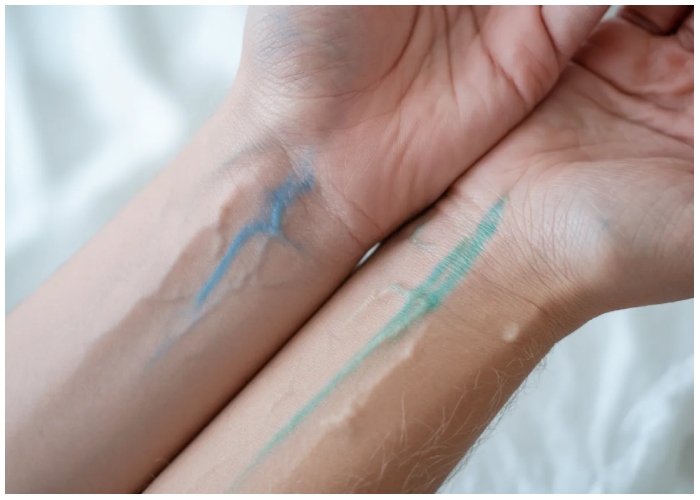Knowing your skin undertone can make a huge difference in how your clothes and makeup look on you. While it may seem like a small detail, the right color palette can make your skin glow, your eyes pop, and your entire outfit come together effortlessly. Here’s how to figure out your undertone—and how to use that information to your stylish advantage.
Step One: Understand Your Undertone
Skin tone refers to how light or dark your skin is, while undertone refers to the subtle hue beneath the surface. Undertones generally fall into three categories: warm, cool, and neutral.
- Warm undertones have hints of yellow, peach, or golden.
- Cool undertones lean toward pink, red, or blue.
- Neutral undertones are a mix of both, or neither is dominant.
How to Find Your Undertone
There are several methods to help you determine your undertone. Try using more than one for the clearest result.
- Vein Test: Look at the veins on your wrist. Greenish veins often indicate warm undertones, while bluish or purplish veins suggest cool undertones. If you can’t tell, you may be neutral.

- Jewelry Test: Gold jewelry tends to flatter warm undertones, while silver looks best on cool tones. If both look great, you’re probably neutral.
- White Fabric Test: Hold up a white shirt or cloth next to your face in natural light. If your skin looks rosy or pink, you’re likely cool. If you appear more golden or yellow, you’re warm.
- Sun Reaction Test: Think about how your skin reacts to sun exposure. If you burn easily, you likely have cool undertones. If you tan more easily, you might be warm or neutral.
Colors That Flatter Warm Undertones
If you have warm undertones, earthy shades will look amazing on you. Think of colors inspired by a sunset or autumn landscape. These colors enhance the warmth in your skin and provide a natural glow.
- Best Colors: Rich browns, mustard yellow, burnt orange, olive green, warm reds, terracotta, and creamy ivory.
- Metallics: Gold and copper look especially flattering. These tones reflect the golden warmth in your complexion.
- Avoid: Icy blues, cool grays, and jewel tones, which may wash you out or create a stark contrast.
Try incorporating these shades into your wardrobe staples, such as coats, blazers, and dresses. You’ll notice how much brighter and more cohesive your entire look becomes.
Colors That Flatter Cool Undertones
Cool undertones shine in colors that reflect a crisp, wintery vibe. These shades bring out the pink and blue tones in your complexion and enhance the contrast in your features.
- Best Colors: Sapphire blue, emerald green, lavender, plum, charcoal, true red, and icy pink.
- Metallics: Silver and white gold are your best friends. They create a balanced, clean effect against your natural coloring.
- Avoid: Earth tones like rust, mustard, and olive, which can dull your features or create a washed-out look.
Consider using these colors for key wardrobe pieces like scarves, blouses, or formalwear. They provide a refined and elegant appearance.
Colors That Flatter Neutral Undertones
Lucky you! Neutral undertones give you the most versatility. You can mix and match from both warm and cool palettes without clashing.
- Best Colors: Teal, jade green, blush pink, soft white, dusty rose, and medium gray.
- Metallics: Rose gold and champagne tones complement beautifully and bring a soft elegance.
- Avoid: Super saturated shades or neons, which can overpower your balanced tone and feel too harsh.
When selecting clothing, look for soft tones and muted versions of bold colors. These create a harmonious look that enhances your natural balance.
Tips for Building a Wardrobe Around Your Undertone
- Start With Staples: Choose basics in your most flattering neutral tones—like navy for cool, camel for warm, or taupe for neutral. These staples will create a cohesive base for any outfit.
- Add Color in Layers: Use scarves, cardigans, or accessories in your optimal shades to brighten up an outfit. It’s a great way to experiment without overwhelming your look.
- Don’t Ditch Favorites: If you love a color that doesn’t suit your undertone, wear it away from your face—like on pants or shoes. You can also balance it with a scarf or top in a better shade.
- Try Before You Buy: Always check colors in natural lighting, especially if you’re investing in a signature piece. Store lighting can be misleading.
- Use Makeup for Harmony: Lipsticks, blushes, and eyeshadows that match your undertone can enhance your whole look, especially when wearing borderline shades.
Why It Matters
Wearing the right colors can make you look healthier, more vibrant, and even younger. It brings harmony between your skin tone and your outfit, giving you a put-together look with minimal effort. Plus, it cuts down on impulse buys that end up unworn. Instead of fighting your natural features, you’re enhancing them.
Dressing according to your undertone isn’t about rules—it’s about unlocking what enhances your natural beauty. With just a little insight, you can make your closet work smarter for you and feel more confident every time you get dressed. Once you get in tune with your tones, shopping becomes more intentional, and you’ll love what you see in the mirror.